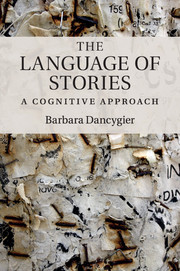Book contents
- Frontmatter
- Contents
- Figures
- Acknowledgements
- Introduction
- 1 Language and literary narratives
- 2 Blending, narrative spaces, and the emergent story
- 3 Stories and their tellers
- 4 Viewpoint
- 5 Referential expressions and narrative spaces
- 6 Fictional minds and embodiment in drama and fiction
- 7 Speech and thought in the narrative
- 8 Stories in the mind
- Notes to the text
- References
- Literary works cited
- Index
2 - Blending, narrative spaces, and the emergent story
Published online by Cambridge University Press: 05 November 2011
- Frontmatter
- Contents
- Figures
- Acknowledgements
- Introduction
- 1 Language and literary narratives
- 2 Blending, narrative spaces, and the emergent story
- 3 Stories and their tellers
- 4 Viewpoint
- 5 Referential expressions and narrative spaces
- 6 Fictional minds and embodiment in drama and fiction
- 7 Speech and thought in the narrative
- 8 Stories in the mind
- Notes to the text
- References
- Literary works cited
- Index
Summary
When he woke up, the dinosaur was still there.
(The Dinosaur, Augusto Monterroso)Stories can, naturally, be treated as linguistic constructions. They are attested examples of natural written discourse, and, while it is possible to treat linguistic choices in the narrative as primarily rhetorical, there is also crucial reliance on very basic facts of language structure. Stories should also be talked about in terms of meaning. They are particularly challenging in this respect, if only because of the sheer length of the text and the variety of narrative options available. This project proposes a framework which makes the discussion of the meaning of stories possible. It relies heavily on analytic tools established within the discipline of cognitive linguistics (mental spaces theory, construction grammar, and frame theory), but it is primarily focused on the theory of blending, or conceptual integration.
Fictional narratives rely on a variety of linguistic phenomena, but adapt them to their needs. To give just one example, they use personal pronouns and deixis in ways which exploit the default spoken setting, but set it against a different kind of deictic ground. Thus a pronoun like I is often used in novels to represent the narrator – a narrative construct, rather than an actual communicator. The discourse setting is that of a communicative act occurring across a spatial and temporal distance, with no clear addressee available (other than some generic reader). The consequences of such a set-up are far-reaching, as they create the need for a different treatment of referential expressions designating characters and put the concepts such as the ‘present’ or the ‘past’ in a different context. These peculiarities will be discussed throughout this book.
- Type
- Chapter
- Information
- The Language of StoriesA Cognitive Approach, pp. 31 - 57Publisher: Cambridge University PressPrint publication year: 2011

